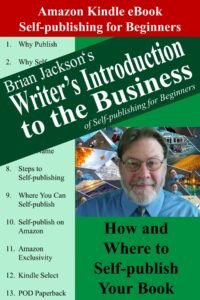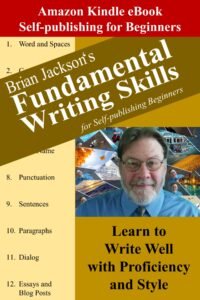As a brand-new author, you’ll right away be faced with one of the most important questions of your career; namely, whether to self-publish your work or search for an agent to represent your work to the traditional publishing industry, typically based in New York. I’m a strong advocate of the self-publishing route, having had experience with both options.
In this chapter, I’ll be discussing the pluses and minuses of the self-publishing and the traditional publishing options. Remember, I am biased, so I wouldn’t expect a completely balanced view from my standpoint. Still, I’ll make this one attempt to be as honest as I can in representing the two options.
Ultimately, the answer for you may be to do both.
Traditional New York Agent and Editor Publishing
Traditional publishing begins with the lengthy process of finding a decent agent to represent you. In most cases, your agent will be a useless sponge to whom you pay 15% of your revenue; but if you get lucky, they will eventually find you a publisher. Congratulations, you’ve just acquired two new bosses.
My wife, Melanie Jackson, published with the New Your publishing house Dorchester Publishing for ten years. Before that, she spent four years writing while looking for an agent. In the end, she chose to self-publish her future work rather than stick with New York.
The following is an explanation for this decision.
One of the first things that Melanie encountered after joining Dorchester was that she now had two new bosses: her agent and her content editor. Her agent insisted on reviewing her work and even refused to represent work that the agent didn’t deem worthy. In the meantime, her content editor provided additional editorial feedback which was often difficult for Melanie to accept.
During her time with Dorchester, Melanie managed to have two books published per year. She could have written faster than that, but two books a year was the most that Dorchester could accept. Ultimately, she averaged approximately $10,000 per year in royalties publishing her two books.
When Dorchester closed its door in 2000, Melanie found herself out of a job. Based on my success self-publishing a handful of books, I was able to convince Melanie to join me in self-publishing her new line of cozy mysteries. During the next five years, we managed to publish over 100 books and made approximately $500,000.
The following are some things to consider before choosing a publishing path.
Publishers Provide Little Bang for the Buck
Winnowing out rejects, editing, providing a cover, production, distribution, and advertising. What more can a traditional publisher do?
For years, traditional, hardcopy publishers have had a stranglehold on the publishing industry, deciding what gets published and what does not. Actually, it’s worse than that. Six major publishers, with a handful of editors each, have been deciding what America wants to read. That’s because everything was in hardcopy and the publishers owned the presses and the distribution channels.
Well, thankfully, that is no longer the case.
With the advent of eBook publication, publishers have lost their stranglehold on the two key elements which could not previously be circumvented by the self-publisher. Namely, production and distribution. Now the self-published author can produce digital media and distribute via Amazon, Barnes and Nobel, SmashWords, and CreateSpace (note: this last option is actually Print on Demand (POD) hardcopy site). The rest of the traditional publisher’s services can be easily replaced.
Save Time – Publish Now and Often!
When you work for a publishing house, you publish when your publisher says and how often they say. This can often mean publishing as little as once every two years.
When self-publishing, you get to publish your work right now and continue to publish when you want, what you want and as frequently as you want.
This benefit to self-publishing allows you to be as lazy or as productive as you’d like. It leaves you in control of your life.
Publish When and What You Want
Along the same lines as being able to publish now and often, the self-publishing route allows you to publish when and what you want. While publishing with Dorchester, Melanie was forced into writing Scottish historical romance novels even though she was more interested in writing paranormal romance. By the end of her career with Dorchester, she was getting interested in writing cozy mysteries. And, again, she was restricted to publishing twice per year.
While self-publishing, Melanie and I managed to publish a book every two months. The result was a massive influx of money and days spent in a writing frenzy. Melanie focused on writing cozy mysteries to her heart’s content for five years until she retired. To this day, we continue to make approximately $1000 per month on her back catalog of books.
Retain Control of Your Business
By choosing to self-publish, you’re retaining control of the entire publishing process. While with Dorchester, Melanie used to have a horrible time getting the book covers she wanted out of the art department. As a self-publisher, I was able to create exactly the book covers she wanted, and if she changed her mind, I simply changed the covers.
With traditional publishing, you’re at the mercy of your publishing company as to whether you’re going to sink or swim. You’re responsible for the entire process, including what you write, when you write it, copy editing, book cover and publishing. On the downside, you’re responsible for the entire process, including what you write, when you write it, copy editing, book cover and publishing.
At first glance, it would seem to be a boon to be backed by a publisher who can provide free book cover and editing services and market your book. In reality, traditional publishing removed your options and ultimately left it to you to market your own book.
Make More Money
During her ten years with Dorchester, Melanie made $100,000. During her second full year of self-publishing, she made $198,000. The fact is that if you’re industrious, you can make considerably more money from self-publishing than you can from traditional publishing. Just look at the numbers.
A New York publisher will publish a Kindle eBook on Amazon for $5.99. Of the revenue generated by that book, Amazon keeps 65% and your publisher another 27% leaving you with 8%. Of your 8%, you owe your agent 15% leaving you with 6.8% of the revenue, or $0.41. The high initial price is required for everyone to get a decent cut (except the author) but also drives down the number of sales.
A self-publisher will publish that same Kindle eBook on Amazon for only $2.99 to produce increased sales. Of the revenue generated by that book, Amazon keeps 30%, and that’s it. You keep 70% of the revenue generated by the sale of the book. That’s $2.09 per book sold or five times the revenue per book.
In reality, a publisher will probably manage to sell more books than you can, so you may break even on revenue. Additionally, many small publishing houses offer the author up to a 25% cut of the royalties, so the disparity isn’t as great as what I depicted.
Still, comparing ten years with Dorchester that produced a total revenue of $100,000, against five years of self-publishing that produced $500,000, means that in our experience, Melanie and I were able to generate ten time more revenue self-publishing than she was with traditional publishing.
Diversification
I’ve found that the most successful authors are those who manage to cross-market a diverse product line. If you’re a writer, or soon to become one, consider writing series of both fiction books and non-fiction books. Consider adding Youtube videos and potentially Udemy online training videos. Webinars, blogging, podcasts, affiliate marketing … The list of ways to make money online stretches on-and-on. Use them all to build a marketing empire anchored by your writing.
However, the point of this chapter is to appeal to those of you who currently do everything but write to add a book to your product line. Are you a doctor, architect, educator, consultant, creative writing teacher or anyone else whose career could benefit from the mere fact that you’ve written and published a book?
Let me show you how to do it all. It’s inexpensive. It’s easy. It’s fun. It’s the classic example of an online source of passive income. The series is even modular so that you can buy and learn only the topics in which you’re interested.
The Downside to Self-publishing
To summarize, the upside to self-publishing is that you have sole control and responsibility for everything. The obvious downside to self-publishing is that you have sole control and responsibility for everything.
I know that many writers say they just want to write. If that’s truly the case, then I suggest you wait for a lucrative contract to arrive on your doorstep. I understand there may be ways to expedite this process.
In the meantime, you just might want to try self-publishing a book or two. You never know but that the habit might stick.
By the way, if you are offered money by anyone for your work, then you should give that offer serious consideration. Any offer of money is too rare these days to ignore. Though I would suggest, you watch out for what you’re signing away via the contract and for what you’re receiving in return.
That said, I still want to see everything written by everyone published, even the works that were deemed unacceptable by the big six in New York and the “indie” publishers.
If you’re one of the few who score it big right off the bat with your writing, then I would like to congratulate you and wish you the best of luck. However, this book can provide you with no advice.
If there’s no one knocking at your door right with a contract in their hand, then you should keep reading…
Prepare for New York Publication
Still can’t decide which way to go? How about doing both.
If you are still interested in traditional publishing (possibly for the prestige involved), you should consider self-publishing while you search for an agent.
Ask yourself this: Wouldn’t an agent and publisher be more willing to take me on if I had a backlog of successfully self-published books? The answer is an emphatic “yes”!
I’ll see you in the classroom,
—Brian


















